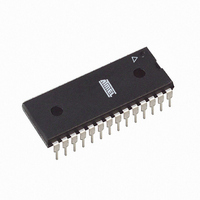ATMEGA168-20PU Atmel, ATMEGA168-20PU Datasheet - Page 22

ATMEGA168-20PU
Manufacturer Part Number
ATMEGA168-20PU
Description
IC AVR MCU 16K 20MHZ 28DIP
Manufacturer
Atmel
Series
AVR® ATmegar
Datasheets
1.ATAVRTS2080B.pdf
(378 pages)
2.ATMEGA48-20AU.pdf
(35 pages)
3.ATMEGA88-20MU.pdf
(33 pages)
4.ATMEGA168-20AU.pdf
(359 pages)
Specifications of ATMEGA168-20PU
Core Processor
AVR
Core Size
8-Bit
Speed
20MHz
Connectivity
I²C, SPI, UART/USART
Peripherals
Brown-out Detect/Reset, POR, PWM, WDT
Number Of I /o
23
Program Memory Size
16KB (8K x 16)
Program Memory Type
FLASH
Eeprom Size
512 x 8
Ram Size
1K x 8
Voltage - Supply (vcc/vdd)
2.7 V ~ 5.5 V
Data Converters
A/D 6x10b
Oscillator Type
Internal
Operating Temperature
-40°C ~ 85°C
Package / Case
28-DIP (0.300", 7.62mm)
Processor Series
ATMEGA16x
Core
AVR8
Data Bus Width
8 bit
Data Ram Size
1 KB
Interface Type
2-Wire, SPI, USART, Serial
Maximum Clock Frequency
20 MHz
Number Of Programmable I/os
23
Number Of Timers
3
Operating Supply Voltage
2.7 V to 5.5 V
Maximum Operating Temperature
+ 85 C
Mounting Style
Through Hole
3rd Party Development Tools
EWAVR, EWAVR-BL
Development Tools By Supplier
ATAVRDRAGON, ATSTK500, ATSTK600, ATAVRISP2, ATAVRONEKIT
Minimum Operating Temperature
- 40 C
On-chip Adc
10 bit, 6 Channel
A/d Inputs
6-Channel, 10-Bit
Cpu Speed
20 MIPS
Eeprom Memory
512 Bytes
Input Output
23
Interface
I2C/SPI/UART/USART
Memory Type
Flash
Number Of Bits
8
Package Type
28-pin PDIP
Programmable Memory
16K Bytes
Timers
2-8-bit, 1-16-bit
Voltage, Range
4.5-5.5 V
Controller Family/series
AVR MEGA
No. Of I/o's
23
Eeprom Memory Size
512Byte
Ram Memory Size
1KB
Rohs Compliant
Yes
For Use With
ATSTK600-TQFP32 - STK600 SOCKET/ADAPTER 32-TQFPATSTK600 - DEV KIT FOR AVR/AVR32770-1007 - ISP 4PORT ATMEL AVR MCU SPI/JTAGATAVRDRAGON - KIT DRAGON 32KB FLASH MEM AVRATAVRISP2 - PROGRAMMER AVR IN SYSTEMATJTAGICE2 - AVR ON-CHIP D-BUG SYSTEM
Lead Free Status / RoHS Status
Lead free / RoHS Compliant
Available stocks
Company
Part Number
Manufacturer
Quantity
Price
Part Number:
ATMEGA168-20PU
Manufacturer:
ATMEL/爱特梅尔
Quantity:
20 000
8. Errata
8.1
8.1.1
8.1.2
8.1.3
22
Errata ATmega48
ATmega48/88/168
Rev. D
Rev. C
Rev. B
The revision letter in this section refers to the revision of the ATmega48 device.
•
1. Interrupts may be lost when writing the timer registers in the asynchronous timer
•
•
1.
2. Interrupts may be lost when writing the timer registers in the asynchronous timer
•
1. Interrupts may be lost when writing the timer registers in the asynchronous timer
Interrupts may be lost when writing the timer registers in the asynchronous timer
Reading EEPROM when system clock frequency is below 900 kHz may not work
Interrupts may be lost when writing the timer registers in the asynchronous timer
Interrupts may be lost when writing the timer registers in the asynchronous timer
If one of the timer registers which is synchronized to the asynchronous timer2 clock is writ-
ten in the cycle before an overflow interrupt occurs, the interrupt may be lost.
Problem Fix/Workaround
Always check that the Timer2 Timer/Counter register, TCNT2, does not have the value 0xFF
before writing the Timer2 Control Register, TCCR2, or Output Compare Register, OCR2.
The only safe time to write to any of the Timer2 registers in asynchronous mode is in a com-
pare interrupt routine where the compare register is not 0xFF, or if the compare register is
0xFF, after a delay of at least one asynchronous clock cycle from the start of the interrupt.
Reading EEPROM when system clock frequency is below 900 kHz may not work
Reading Data from the EEPROM at system clock frequency below 900 kHz may result in
wrong data read.
Problem Fix/Workaround
Avoid using the EEPROM at clock frequency below 900 kHz.
If one of the timer registers which is synchronized to the asynchronous timer2 clock is writ-
ten in the cycle before an overflow interrupt occurs, the interrupt may be lost.
Problem Fix/Workaround
Always check that the Timer2 Timer/Counter register, TCNT2, does not have the value 0xFF
before writing the Timer2 Control Register, TCCR2, or Output Compare Register, OCR2.
The only safe time to write to any of the Timer2 registers in asynchronous mode is in a com-
pare interrupt routine where the compare register is not 0xFF, or if the compare register is
0xFF, after a delay of at least one asynchronous clock cycle from the start of the interrupt.
If one of the timer registers which is synchronized to the asynchronous timer2 clock is writ-
ten in the cycle before an overflow interrupt occurs, the interrupt may be lost.
2545LS–AVR–08/07

















